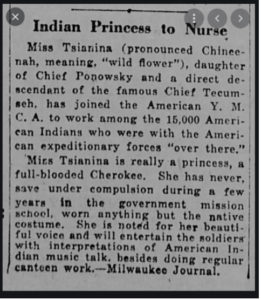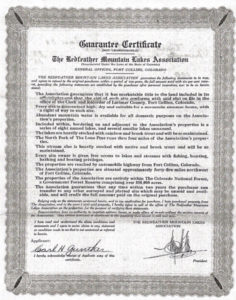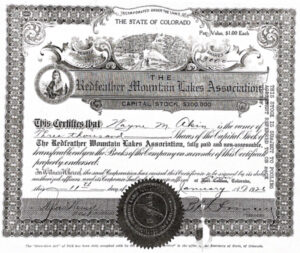By Wayne M. Akin. As written in a letter to Joan Day (Fort Collins historian) … on July 10, 1988
Click here to download a printable PDF of this memoir.
It was good to hear from you and I enjoyed the clipping and program for the Red Feather play. Am I correct that they made a TV cassette of it? If so, I’d like to see it and if you want a copy for the museum, I’d be glad to buy it and give it to you after I’ve looked at it.
You asked about the history of the lakes and their names. As I remember it, the lakes were made about 1885-88 by a man named Jake Mitchell (who diverted water from the North Pine Creek and thus created the water rights for the lakes). They were called Mitchell Lakes. The individual lakes were — Big or West Lake (Hiawatha), House Lake (Ramona), and South Lake (Red Feather).
About 1889 the South Pine was diverted by Frank Gartman (a local rancher) to form Twin Lake (or West Lake) and Dowdy Reservoir. The whole group were combined and called Mitchell Lakes.
In 1902 a group, including former Governor B. H. Eaton, Jake Mitchell and Frank Gartman planned a resort, but it fell though. Frank Stover and Nettie Poor purchased the lakes and she built her home on the so-called House Lake and developed a business supplying trout to Pell’s Oyster House in Denver.
In 1904 my father and Jesse Harris purchased the lakes and surrounding land and then added the adjoining properties to make up the ranch were we lived during the summer months.
Lady Moon was an Irish girl, Catherine Lauder, who came to work at the Elkhorn Lodge located a few miles southeast of the lakes. It served the miners who worked in the area. She married a local rancher, Frank Gartman, whom I mentioned above. I do not remember what became of him but later she married Lord Cecil Moon — who was one of the many younger sons of English nobility who came to the western U.S. about that time. She divorced him but remained on the ranch and kept the title “Lady Moon”. She was a
remarkable cantankerous woman who made life very interesting in the neighborhood.
To return to my point of departure — about 1918 or so my father sold forty acres and South Lake to Dr. D. O. Morton (our family doctor) and L.C. Moore, President of the 1st National Bank. They built summer homes there. Dr. Morton was a friend of composer Charles Wakefield Cadman and thus through him, our family became good friends with him. Tsianina was not a princess but she was a very talented Indian girl who won a scholarship to study music in Denver where Cadman met her. He became her “mentor” and later composed an opera with her singing the lead role. There is a long story about her concerts when my sister Eunice was her accompanist. However, the point here is that Cadman and Tsianina visited Dr. Morton at the summer home and he asked her if the name meant anything in English. She replied Red Feather….* Dr. Norton had been trying to think of a more romantic name than “South Lake” and this seemed to be perfect. So his lake became Red Feather Lake.
So a few years later when the developing was started it was natural to choose the name Red Feather Lakes Association and give Indian names to the other nearby lakes. **
I’m delighted that you are taking on the very big job of fostering the museum. I hope you get the necessary funds. A museum can be very important and valuable historical material will be lost if the search is interrupted at a time when this generation of pioneers is about to disappear.
There are a couple of little books about Red Feather which must be in the library and you should have copies in the museum. One is “Red Feather Lakes; The first Hundred Years” by Evadine B. Swanson and Ted Dunning.
I do not remember the other one’s name or author, but I think its name is simply “Red
Feather Lakes.”
Also there is another about the general area — “Memories of an Old Timer” by Wesley Swan. My recollection is that it has a lot of information valuable for a Larimer County Museum.
I hope this gives you something you wanted — if not, ask more questions. Maybe it will
stimulate an old memory that certainly needs stimulation.
Best wishes — as ever.
Wayne
** Several of the “Indian” names for the lakes come from the epic poem “Song of Hiawatha” by the 19th century American poet Henry Wadsworth Longfellow, including Hiawatha and Nokomis (prominent lake names in Minneapolis, MN also), and possibly Shagwa which appears in Longfellow’s long poem as Shuh-shuh-gah, meaning blue heron and is also close to the name Shagawa which is the name of another lake in
Minnesota near Ely.
Dear Joan / October 23, 1989
In going over old papers I came on to these stock certificates. The Redfeather Mountain Lake Assn. is long gone but these may have some interest.
Wayne M. Akin
1232 East Palo Verde Drive
Phoenix, Arizona 85014


